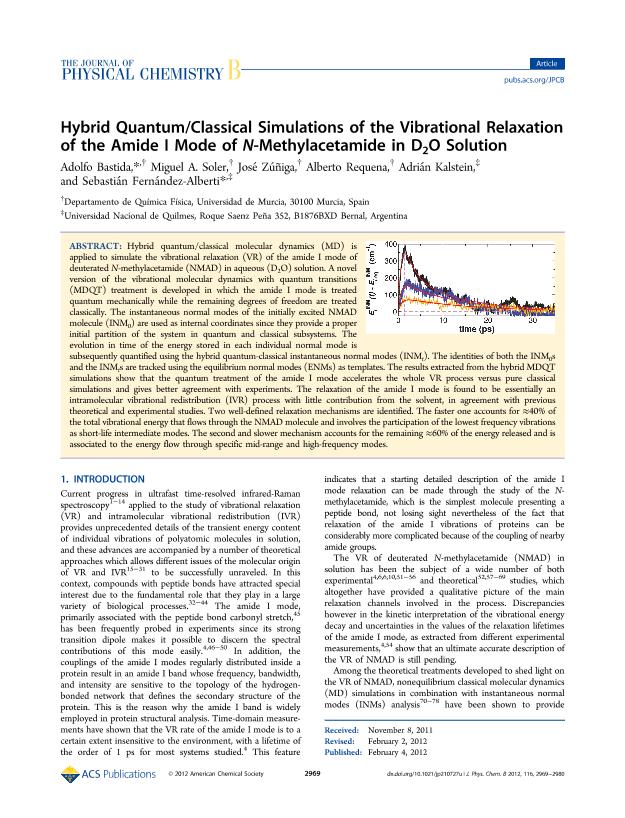Mostrar el registro sencillo del ítem
dc.contributor.author
Bastida, Adolfo

dc.contributor.author
Soler, Miguel A.
dc.contributor.author
Zúñiga, José
dc.contributor.author
Requena, Alberto
dc.contributor.author
Kalstein, Adrian

dc.contributor.author
Fernández Alberti, Sebastián

dc.date.available
2023-02-27T10:55:56Z
dc.date.issued
2012-02
dc.identifier.citation
Bastida, Adolfo; Soler, Miguel A.; Zúñiga, José; Requena, Alberto; Kalstein, Adrian; et al.; Hybrid Quantum/Classical simulations of the vibrational relaxation of the Amide I mode of N-methylacetamide in D2O solution; American Chemical Society; Journal of Physical Chemistry B; 116; 9; 2-2012; 2969-2980
dc.identifier.issn
1520-6106
dc.identifier.uri
http://hdl.handle.net/11336/188902
dc.description.abstract
Hybrid quantum/classical molecular dynamics (MD) is applied to simulate the vibrational relaxation (VR) of the amide I mode of deuterated N-methylacetamide (NMAD) in aqueous (D2O) solution. A novel version of the vibrational molecular dynamics with quantum transitions (MDQT) treatment is developed in which the amide I mode is treated quantum mechanically while the remaining degrees of freedom are treated classically. The instantaneous normal modes of the initially excited NMAD molecule (INM0) are used as internal coordinates since they provide a proper initial partition of the system in quantum and classical subsystems. The evolution in time of the energy stored in each individual normal mode is subsequently quantified using the hybrid quantum-classical instantaneous normal modes (INMt). The identities of both the INM0s and the INMts are tracked using the equilibrium normal modes (ENMs) as templates. The results extracted from the hybrid MDQT simulations show that the quantum treatment of the amide I mode accelerates the whole VR process versus pure classical simulations and gives better agreement with experiments. The relaxation of the amide I mode is found to be essentially an intramolecular vibrational redistribution (IVR) process with little contribution from the solvent, in agreement with previous theoretical and experimental studies. Two well-defined relaxation mechanisms are identified. The faster one accounts for ≈40% of the total vibrational energy that flows through the NMAD molecule and involves the participation of the lowest frequency vibrations as short-life intermediate modes. The second and slower mechanism accounts for the remaining ≈60% of the energy released and is associated to the energy flow through specific mid-range and high-frequency modes.
dc.format
application/pdf
dc.language.iso
eng
dc.publisher
American Chemical Society

dc.rights
info:eu-repo/semantics/openAccess
dc.rights.uri
https://creativecommons.org/licenses/by-nc-sa/2.5/ar/
dc.subject
vibrational relaxation
dc.subject
intramolecular energy redistribution
dc.subject
normal modes
dc.subject.classification
Físico-Química, Ciencia de los Polímeros, Electroquímica

dc.subject.classification
Ciencias Químicas

dc.subject.classification
CIENCIAS NATURALES Y EXACTAS

dc.title
Hybrid Quantum/Classical simulations of the vibrational relaxation of the Amide I mode of N-methylacetamide in D2O solution
dc.type
info:eu-repo/semantics/article
dc.type
info:ar-repo/semantics/artículo
dc.type
info:eu-repo/semantics/publishedVersion
dc.date.updated
2023-02-26T15:31:26Z
dc.journal.volume
116
dc.journal.number
9
dc.journal.pagination
2969-2980
dc.journal.pais
Estados Unidos

dc.journal.ciudad
Washington
dc.description.fil
Fil: Bastida, Adolfo. Universidad de Murcia; España
dc.description.fil
Fil: Soler, Miguel A.. Universidad de Murcia; España
dc.description.fil
Fil: Zúñiga, José. Universidad de Murcia; España
dc.description.fil
Fil: Requena, Alberto. Universidad de Murcia; España
dc.description.fil
Fil: Kalstein, Adrian. Consejo Nacional de Investigaciones Científicas y Técnicas; Argentina. Universidad Nacional de Quilmes. Departamento de Ciencia y Tecnología; Argentina
dc.description.fil
Fil: Fernández Alberti, Sebastián. Universidad Nacional de Quilmes. Departamento de Ciencia y Tecnología; Argentina. Consejo Nacional de Investigaciones Científicas y Técnicas; Argentina
dc.journal.title
Journal of Physical Chemistry B

dc.relation.alternativeid
info:eu-repo/semantics/altIdentifier/url/http://pubs.acs.org/doi/abs/10.1021/jp210727u
dc.relation.alternativeid
info:eu-repo/semantics/altIdentifier/doi/http://dx.doi.org/10.1021/jp210727u
Archivos asociados
